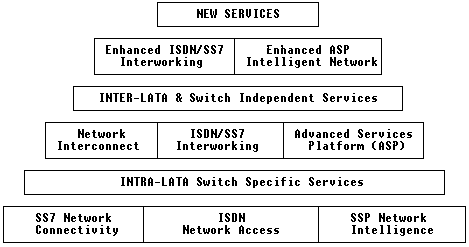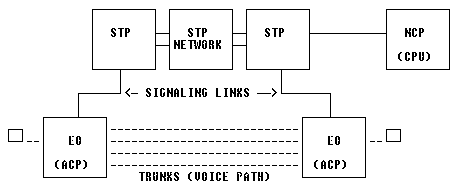| RETURN | Voice Networking |
Digital Signaling Systems
The rapid deployment of digital PBXs is resulting in greater interconnectivity to Link Series multiplexers at the T1 and E1 levels. Therefore, an increased awareness of digital signaling concepts is required. The following subsections cover:
– Per-Channel Signaling Schemes
– Common Channel Signaling Schemes
The matrix below illustrates the capabilities of analog and digital signaling systems defined by CCITT:
------------------------------------------------------------------------------
| | Signaling System |CCITT | CCITT |CCITT | CCITT |
| FEATURE |-------------------| R1 | R1 | R2 | R2 |
| |# 3|# 4|# 5|# 6|# 7|Analog|Digital|Analog|Digital|
|--------------------------|---|---|---|---|---|------|-------|------|-------|
|Inband Signaling | X | X | X | - | - | X | - | X | - |
|Outband Signaling | - | - | - | - | - | - | - | X | - |
|Common Channel Signaling | - | - | - | X | X | - | - | - | - |
|Digital Transmission | - | - | - | X | X | - | X | - | X |
|DTMF | - | X | X | - | - | - | - | - | - |
|MF | - | - | X | - | - | X | X | X | X |
|Operation over Satellites | - | - | X | X | X | X | X | - | - |
------------------------------------------------------------------------------
Per-Channel Signaling Systems
- T1 Channel Bank (ATT Pub 43801)
- E1 Channelization (CCITT Recommendation G.732)
T1 Channel Bank Signaling
In DS-1 (T1) systems, the signaling bit is transported in the eighth bit position within the DS0 timeslot, but only during certain ‘frames’ of the ‘superframe’.
For D4 channel banks, a four-state signaling scheme is implemented through the use of an ‘A-bit’ (transmitted in the 6th frame), and a ‘B-bit’ (transmitted in the 12th frame).
For D5 channel banks (Extended Superframe), a sixteen-state signaling is implemented through an ‘A-bit’ (transmitted in the 6th frame), a ‘B-bit’ (transmitted in the 12th frame), a ‘C-bit’ (transmitted in the 18th frame), and a ‘D-bit’ (transmitted in the 24th frame).
D4 signaling is described in ATT Pub 43801, ‘Digital Channel Bank Requirements and Objectives’. The mapping of 2 and 4 state signaling schemes to ESF framing (16-state) is also described and tabulated below:

CCITT G.732 Signaling
CCITT Recommendation G.732 details a Channel Associated Signaling (CAS) scheme. In this recommendation (which is not a formal standard signaling system), DS0 #16 of the G.732 frame is used to transport a multiplexed ABCD-Bit status for each channel.
Common Channel Signaling (CCS) Systems
Common channel signaling systems are usually HDLC-based, message oriented sigaling systems. Within the United States PSTN the original implementation of Common Channel Signaling started in 1976, and is known as CCIS (Common Channel Interoffice Signaling). This is similar to CCITT’s Signaling System #6 (SS6). The CCIS protocol operated at relatively low bit rates (2.4K, 4.8K, 9.6K), but transported messages that were only 28 BITS long. However, CCIS could not adequately support an integrated voice and data environment. Therefore, a new HDLC-based signaling standard and CCITT recommendation was developed: Signaling System 7.
First defined by the CCITT in 1980, the Swedish PTT started SS7 trials in 1983 and some European countries are now entirely SS7-based.
Within the US, Bell Atlantic began implementing SS7 in 1988, among the first BOCs (if not the first) to do so.
Currently, a large majority of the Long Distance networks and Local Exchange Carrier networks have migrated to implementations of CCITT’s Signaling System 7 (SS7). By 1989, AT&T converted had converted all of its digital network to SS7; and US Sprint is SS7 based. However, many LECs are still in the process of upgrading their networks to SS7. This is because the number of switch upgrades required for SS7 support impact the LECs much more heavily than the ICs. THE SLOW DEPLOYMENT OF SS7 WITHIN THE LECs IS ALSO, IN PART, RESPONSIBLE FOR DELAYS IN INCORPORATING ISDN (INTEGRATED SERVICES DIGITAL NETWORK) WITHIN THE U.S.
There are three versions of SS7 protocols at the present time:
- CCITT Version (1980, 1984) detailed in CCITT Q.701 - Q.741
- ATT and Telecom Canada (1985)
- ANSI (1986)
The evolution of SS7 into the U.S. PSTN is detailed below:

SS7 currently provides support for POTS (Plain Old Telephone Service) through the use of a Telephony User Part (TUP). This defines the messages that are used to support this service. An additional ISDN User Part (ISUP) has been defined that supports ISDN transport. Eventually, since the ISDN User Part includes translations from POTS to ISDN, the ISDN User Part is expected to eventually solely replace the Telephony User Part.
SS7 Signaling Protocol
While the structure of SS7 is based upon the OSI model, there are some substantial differences found within layers 4-7. The following block diagram indicates the basic SS7 components:

Level 1: SS7 normally operates at rates of 56 KBPS and 64 KBPS.
Level 2: The SS7 protocol utilizes HDLC (w/ zero insertion) techniques.
Messages may be up to 272 bytes (octets) long.
Level 3: Tranfers 3 message types: Link Status Signaling Units
Message Signaling Units
Fill-In Signaling Units
The Link Status Signaling Units convey status and
connection/disconnection information.
The Message Signaling Units carry specific switch instructions
concerning maintenance and call management functions.
The Fill-In Signaling Units are transmitted during idle states.
SS7 Signaling Networks
The SS7 network is accessed by End Offices that communicate to Signal Transfer Points (STPs).
These STPs perform a packet switching function, facilitating highly reliable and cost-effective network architectures.
Physical SS7 network interconnectivity can utilize two schemes:
- Associated Signaling (AS)
- Quasi-Associated Signaling (QAS)
Associated Signaling employs signaling channels that are routed alongside each particular transmission path between end-points. This topology results in a large number of signaling links with relatively low signaling link usage. The STP performs no switching function in this implementation.
In Quasi-Associated Signaling, the signaling links may be separated from the transmission facility and switched by Signal Transfer Points (STPs). Signaling between offices is therefore supported through logical STP-provided connections.
SS7 (ATT implementation) networks also employ Action Control Points (ACP) that can provide switching and routing functions and Network Control Points (NCP). NCPs are typically data processing CPUs, that contain detailed information on how to handle the call (e.g. Virtual Network digit translation, Calling Card verifications, etc.). Communications between an ACP and a NCP may traverse several STPs.
